Bats are a prevalent species in Ontario and survive on a steady diet of insects like moths, flies, mosquitoes, mayflies, beetles, and midges. They are also known as opportunistic animals and will feed on whatever insects they can find. Bats have increasingly adapted to urban lifestyles and will seek out insects in any space imaginable around some cities.
If you are dealing with bats and want to have them removed contact the bat removal specialists at Bat Control for service near you!
Opposite of bats in Ontario is the sub-tropical bats that do eat a varied diet of fruits. Depending on the species of bats you come across in Ontario some may have a little bit of variation in their diet, but you can assume that most stick to insects. The Little Brown Bat lives on a diet of mostly insects that are found over water. Then you have its larger counterpart the Big Brown Bat, which also mostly eats insects but has a preference for beetles. The Big Brown Bat is the second largest bat species in Ontario and is often seen around houses, more specifically attics.
The Eastern Red Bat slightly deviates from the diet, but still mainly focuses on insects, but has a real appetite for moths. They are known to be incredibly fast critters. The Hoary Bat is the largest bat species in Ontario and surprisingly does have a different diet. It still feats mostly on moths but occasionally slips in small snakes and small bats in its mouth. In the winters, it goes South towards Mexico.
The tri-colored bat together with the Small Brown bat is also an endangered species and also lives on a steady diet of insects. The tri-colored bats are the only foliage species that will roost in groups, meaning that they will live in groups. They roost mainly in small spaces. The Eastern Small-footed Myotis is an endangered species in Canada. Not a lot is known about the soma bat other than some data recorded by a few scientists. They roost in small spaces such as behind window shutters
It also happened to be the least studied bat species in Ontario. The Eastern Small-footed Myotis looks a lot like the Little Brown Myotis but smaller in stature along with the darker facial features. The Northern Long-eared Myotis is a small bat as well as the name already implies and has the habit of roosting in human-made structures like attics and sheds. The bat has a wide variety of small insects and anthropoids.
Bats can have a devastating impact on crops contributing to millions upon millions of dollars lost due to them causing mayhem on important crops and grains such as rice and corn. Despite having somewhat of a bad rep in the farming industry, bats are very beneficial for nature. It is estimated that around five hundred flowers rely on the support of bats to pollinate them! Bats are also largely responsible for sowing seeds by dropping them.
Many bat species as mentioned before are endangered and because of this may bats ended up under Schedule 1 under the Species of Risk Act where many of Ontario’s bat species end up. Bats are slow reproducers and thus it is vital to leave them alone at their roosting place. Many kinds of wood and forests that were once home to several bats are being destroyed because of industrialization and have very few places to go. This is why we see bats in urban places so often. This is why bats are to be left alone by law. There are only very specific times of the year where bat removal specialists can interfere by removing them. This can only be done by a trained and insured specialist as causing any sort of harm or injury can result in hefty fines. Call 647-931-6459 for service and to speak to customer service to book an appointment.
